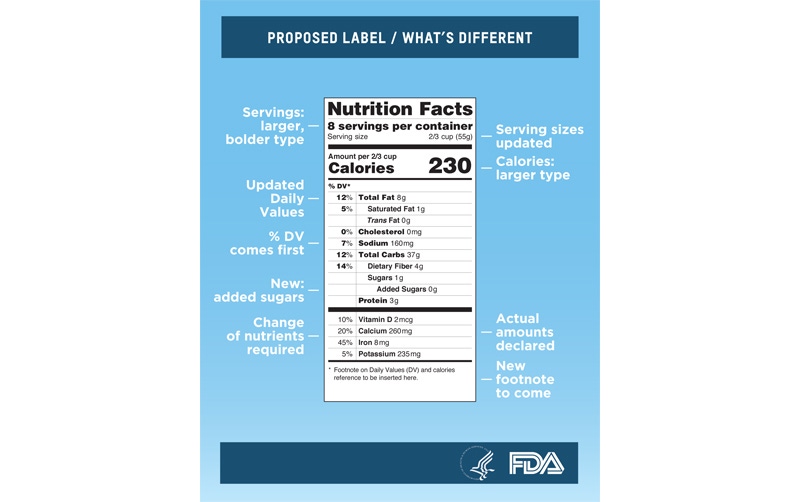May 14, 2014

The U.S. Food and Drug Administration (FDA) published two proposed rules on March 3, 2014, to amend the nutrition labeling requirements for conventional foods and dietary supplements. The changes are being proposed to reflect the latest scientific information, including the link between diet and chronic diseases such as obesity and heart disease, and to better align serving sizes with how much people actually eat. The new Nutrition Facts label is hoped to be more useful to consumers.
The first proposed rule would: (1) update the list of nutrients that are required or permitted to be declared; (2) provide updated Daily Reference Values (DRVs) and Reference Daily Intakes (RDIs); (3) amend requirements for foods specifically for children under the age of four years and for pregnant and lactating women; and (4) revise the format of the Nutrition Facts label.
The second proposed rule would update serving size requirements.
Proposed changes to nutrients required or permitted on labels would impact the labeling of fats, added sugars, vitamins and nutrients, and fiber. The declaration of “Calories from Fat” would no longer be required or allowed. FDA explained that this change is proposed because research shows that the type of fat is more important than the amount. With respect to the labeling of sugars, a declaration of “Added Sugars,” indented under “Sugars,” would be a new requirement. Changes to the declarations of vitamins and minerals include the addition of vitamin D and potassium. Calcium and iron would continue to be required, and vitamins A and C could be included on a voluntary basis.
FDA also proposed to define “Dietary Fiber,” though companies marketing isolated and synthetic non-digestible carbohydrates would have to provide evidence that they have a “physiological effect(s) that is beneficial to human health.” Additionally, for certain products—namely those that contain: non-digestible carbohydrates that do not meet the proposed definition of dietary fiber, more than one source of sugar, added sugars that undergo fermentation, various forms of vitamin E, or folate and folic acid—manufacturers would be required to maintain and permit FDA inspection of certain written records to support these nutrient declarations.
Among the revisions to DRVs and RDIs, FDA is proposing to increase the DV for dietary fiber from 25g to 28g and to reduce the DV for sodium from 2,400mg to 2,300mg. The agency points out that approximately 75 percent of the sodium consumed by the U.S. population is from sodium added to food during processing. Additionally, FDA is proposing to change the units used to declare vitamins A, D and E content.
FDA’s proposal on serving size would include a revised definition of a single-serving container, a requirement for dual-column labeling for certain containers, an update to several reference amounts customarily consumed and technical amendments to various aspects of the serving size regulations.
The proposed change to the serving size requirements is being made to reflect how people eat and drink today, according to FDA. For example, packaged foods—including drinks—that are typically eaten in one sitting would be labeled as a single serving and calorie and nutrient information on the label would be for the entire package. Also, for certain packages that could be consumed in one sitting or multiple sittings, manufacturers would have to provide “dual column” labels to indicate both “per serving” and “per package” calories and nutrient information.
Comments on both proposals are due by June 2, 2014. More information on the proposals can be found at pdlinks.com/NutritionFactsUpdate.
Author George Misko is a partner at Keller and Heckman. Founded in 1962, the respected law firm has a broad practice in the areas of regulatory law, litigation and business transactions, serving both domestic and international clients. Reach him at [email protected].
About the Author(s)
You May Also Like


